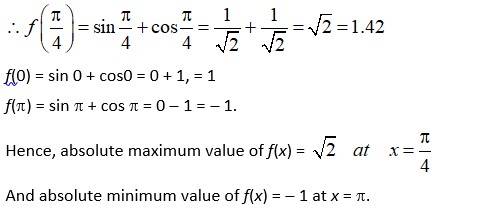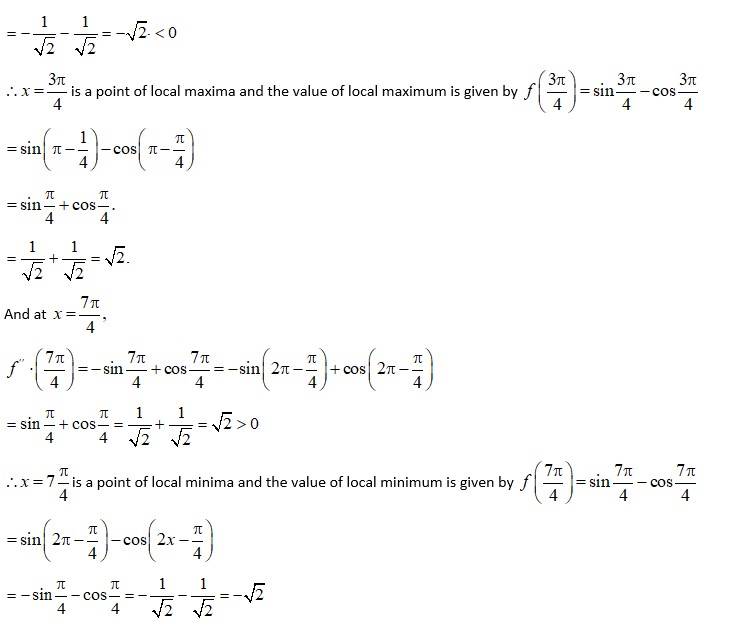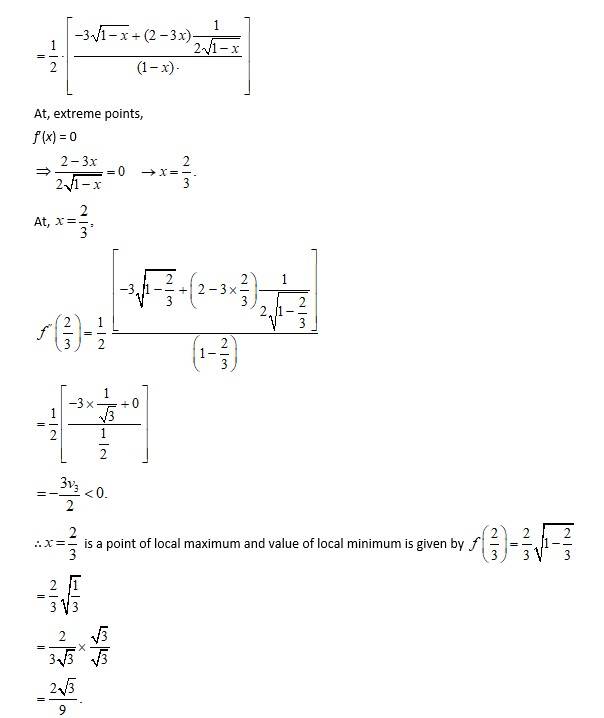Maths
Get insights from 6.5k questions on Maths, answered by students, alumni, and experts. You may also ask and answer any question you like about Maths
Follow Ask QuestionQuestions
Discussions
Active Users
Followers
New answer posted
5 months agoContributor-Level 10
We have, p (x) = 41 -f2x - 18x2.
P (x) = - 72 - 36x
P (x) = -36
At extreme point,
- 72 - 36x = 0
.
At x = - 2, p" (x) = - 36 < 0.
∴x = -2 is a point of local maximum and the value of local
Maximum is given by P (2) = 41 - 72 (- 2) - 18 (- 2)2
41 + 144 - 72 = 113 units.
New answer posted
5 months agoContributor-Level 10
(i) We have,
f(x) = x3 , x ∈ [– 2, 2].
f(x) = 3x2.
At, f(x) = 0
3x2 = 0
x = 0 <--[-2, 2].
We shall absolute the value of f at x = 0 and points of interval [ -2, 2]. So,
f(0) = 0
f(- 2) = (- 2)3 = 8
f(2) = 23 = 8.
∴ Absolute maximum value of f(x) = 8 at x = 2
and absolute minimum value of f(x) = -8 at x = -2.
(ii) f (x) = sin x + cos x , x ∈ [0, π]
A.(ii)
We have, f(x) = sin x + cos x , x ∈ [0, π]
f(x) = cos x - sin x.
atf(x) = 0
cosx - sin x = 0
sinx = cos x

(iii) f(x) = 4x
A.(iii)
We have, f(x) = 4x
f(x) = 4 - x
atf(x) = 0
4- x = 0
x = 4
= 7.87.5
Hence, absolute maximum value of f(x) = 8 at x = 4
and absolute minimum value of f(
New answer posted
5 months agoContributor-Level 10
(i) We have, f (x) = ex
f (x) = ex.
At, extreme points,
f (x) = 0
ex = 0 which has no real 'a' value
∴f (x) has with maximum or minima
(ii) g (x) = log x
A (ii)
We have, g (x) = log x,
g (x) =
At extreme points,
g (x) = 0
1 = 0 which is not true.
∴g (x) was value minima or maxima
(iii) h (x) = x3 + x2 + x + 1.
A (iii)
We have, h (x) = x3 + x2 + x + 1.
h (x) = 3x2 + 2x + 1
At extreme points,
h (x) = 0
3x2 + 2x + 1 = 0

New answer posted
5 months agoContributor-Level 10
(i) we have, f(x) = x2.
f(x) = 2x.
andf(x) = 2.
AR extreme point, f(x) = 0
2x = 0
x = 0.
When x = 0, f(0) = 2 > 0.
∴x = 0 is a point of local minima and value of local minimum is given by f(0) = 02 = 0.
(ii) g(x) = x3 3x
A(ii)
we have, g(x) = x3- 3x
g'(x) = 3x2- 3
g''(x) = 6x.
At extreme point,
g'(x) = 0
3x2- 3 = 0.
3(x2- 1) = 0 ⇒ 3(x - 1)(x + 1) = 0.
x = 1 or x = -1.
At x = 1, g"(1) = 6.1 = 6 > 0.
So, x = 1 is a point of local minima and value of local minimum is given by g(1) = 13- 3.1 = 1 - 3 = - 2.
And at x = -1, g"( -1) = 6 ( -1) = 6 < 0.
So, x = -1 is a point of local minima and value of local minimum is given by
g(- 1) = (- 1)3- 3(- 1) = 1 + 3 = 2.
New answer posted
5 months agoContributor-Level 10
(i) we have, f(x) = |x + 2| - 1
We know that, for all
f(x)- 1.
∴ Minimum value of f(x) = -1 when x + 2 = 0 x = - 2.
And maximum value of f(x) does not exist.
(ii)
A(ii)
We have,
For all
g(x) 3.
∴ Maximum value of g(x) = 3 when
And minimum value does not exist.
(iii) h(x) = sin (2x) + 5.
A(iii)
we have, h(x) = sin (2x) + 5.
For all {range of sine function is [-1, 1]}
-1 + 5 sin 2x + 5 1 + 5.
4 h(x) 6.
∴ Maximum value of h(x) = 6.
Minimum value of h(x) = 4.
(iv)
A(iv)
we have,
As for all
-1 + 3 sin 4x + 3 1 + 3
2 f(x) 4.
∴ Maximum value of f(x) = 4.
Minimum value of f(x) = 2.
(
New answer posted
5 months agoContributor-Level 10
(i) We have, f(x) = (2x - 1)2 + 3.
For all
(2x - 1)2 + 3 ≥ 3.
f(x) ≥ 3.
∴The minimum value of f(x) = 3. When 2x - 1 = 0--> x =
Again as as there is vouppa bound to 'x' value hence, f(x) has no maximum values.
(ii)
A(ii)
We have, f(x) = 92 + 12x + 2.
(Taking 9 common from each team).
For all
f(x)≥ - 2.
∴The minimum value of f(x) = -2 when
And as so f(x) has
no maximum values.
(iii) f(x) = (x - 1)2 + 10
A(iii)
we have, f(x) = - (x - 1)2 + 10
For all
(x - 1)2 ≤ 0
-(x- 1)2 + 10 ≤ 10.
f(x) ≤ 10.
∴maximum value of f(x) = 10 when x - 1 = 0 x = 1.
And minimum value of f(x) does n
New answer posted
5 months agoContributor-Level 10
The volume v of a cube with side 'x' metre is v = x3
So,
∴increase in side, Δx = 3% of =
∴dv = 3x2π
Hence, option (C) is correct.
New answer posted
5 months agoContributor-Level 10
We have, y = f (x) = 3x2 + 15x + 5.
dy = (6x + 15) dx
Δy = (6x + 15) Δx.
Let, x = 3 and Δx = 0.02 then,
Δy = f (x + Δx) - f (x)
f (x + Δx) = f (x) + Δy = f (x) + (6x + 5) Δx.
f (3 + 0.02) = 3 (3)2 + 15 (3) + 5 + (6 * 3 + 15) (0.02).
f (3.02) = 27 + 45 + 5 + (18 + 15) (0.02).
= 77 + 0.66
= 77.66
∴ Option (D) is correct.
New answer posted
5 months agoContributor-Level 10
Let be the radius of the sphere &r be the error in measuring the radius.
Then, π = 9m and Δr = 0.03m.
Now, surface area S of the sphere is
S = 4πr2
So,
∴e, this = Δr = 8πr.Δr = 8π * 9 * 0.03
= 2.16πm3.
Appropriate error in calculating the surface area is 2.16πm3.
New answer posted
5 months agoContributor-Level 10
Let x be the radius of the sphere & Δπ be the error in measuring the radius.
Then, π = 7m and Δr = 0.02m.
Now, volume v of sphere is
So,
dv = 4π (7)2 (.0.02) = 3.92 πm3
∴The appropriate error is calculating the volume is 3.92πm3.
Taking an Exam? Selecting a College?
Get authentic answers from experts, students and alumni that you won't find anywhere else
Sign Up on ShikshaOn Shiksha, get access to
- 65k Colleges
- 1.2k Exams
- 679k Reviews
- 1800k Answers




